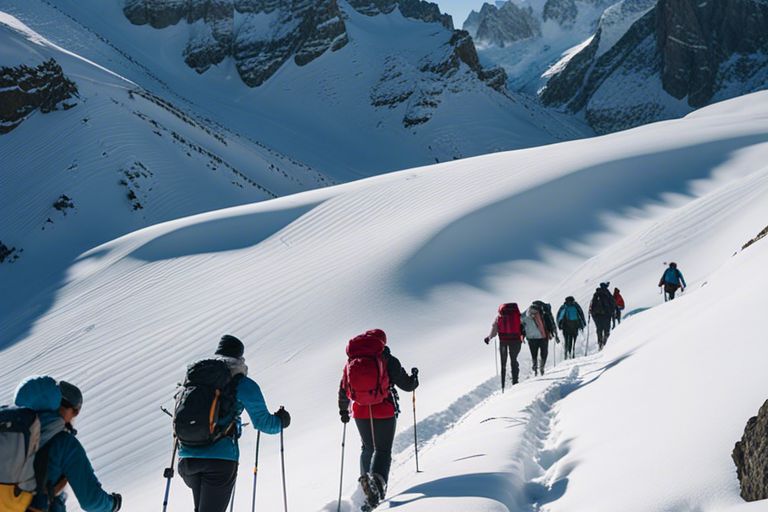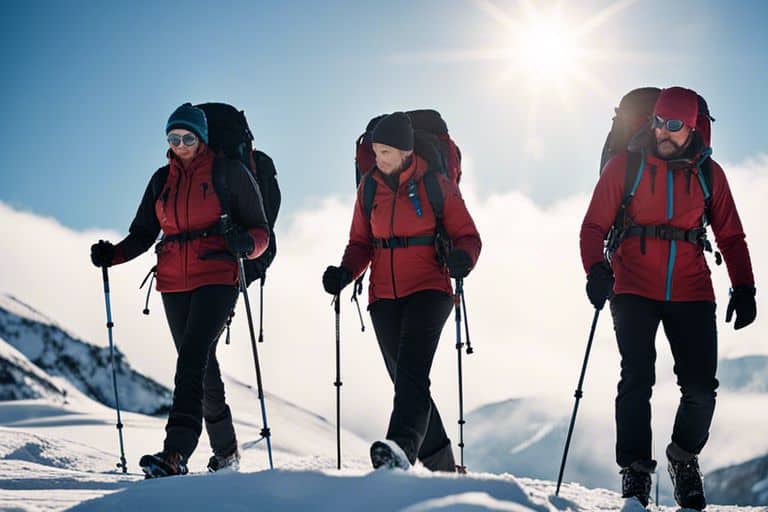One of the most important pieces of gear for a winter hike is your footwear. Investing in a pair of insulated, waterproof boots with good traction is crucial for navigating icy and snowy terrain. Additionally, you’ll want to layer up with moisture-wicking clothing to keep sweat from chilling you. Don’t forget to pack extra layers, including a warm hat and gloves, in case the weather takes a turn for the worse. And of course, always bring plenty of water and high-energy snacks to keep your body fueled and hydrated in the cold. With the proper gear and knowledge, you can safely enjoy the magic of a winter hike.
Key Takeaways:
- Layer up: Proper layering is crucial for staying warm and dry during winter hikes. Invest in moisture-wicking base layers, insulating mid-layers, and a waterproof outer shell.
- Invest in quality winter gear: Quality winter gear, such as waterproof boots, insulated gloves, and a warm hat, is essential for protecting yourself from the elements.
- Carry emergency essentials: Always carry a first aid kit, emergency blanket, and navigation tools in case of unexpected situations during your hike.
- Use traction devices: Utilize traction devices such as microspikes or crampons to prevent slips and falls on icy terrain.
- Check weather and trail conditions: Before embarking on a winter hike, research the weather forecast and trail conditions to ensure a safe and enjoyable experience.
Essential Winter Hiking Gear
Your safety and comfort while winter hiking depend on the gear you bring with you. To ensure you have everything you need, refer to 25 Winter Hiking Tips for Staying Warm and Safe in the Snow. Here are the essential items you’ll need to ensure a safe and enjoyable winter hike.
Layering for Warmth and Agility
Layering is crucial to staying warm and comfortable on your winter hike. Start with a moisture-wicking base layer to keep sweat away from your skin. Next, add an insulating layer to trap heat, and finish with a waterproof and windproof outer layer to protect you from the elements. This layering system allows you to easily adjust your clothing as you warm up or cool down during your hike. Remember, damp clothing can lead to hypothermia, so be sure to bring extra layers in case you need them.
Footwear: Grip, Stability, and Waterproofing
When it comes to winter hiking, your choice of footwear is crucial. Look for insulated and waterproof boots with excellent traction to keep your feet warm, dry, and firmly planted on slick or icy terrain. Consider using traction devices, such as microspikes, to provide additional grip in icy conditions. Proper footwear can make all the difference in preventing slips and falls while hiking in the snow.
Navigational Tools: Staying the Course in Snow
In winter conditions, navigational tools are essential for ensuring you stay on course and avoid getting lost in the snow. Carry a map, compass, GPS device, or smartphone with a reliable navigation app to help you navigate through snowy and potentially obscured trails. It’s easy to lose your bearings when everything is covered in snow, so having these tools on hand is crucial for your safety while winter hiking.
Techniques and Tactics for Winter Hiking
Assuming you have the right gear and the proper clothing for a winter hike, it’s time to brush up on some techniques and tactics to ensure a safe and enjoyable outdoor experience. Winter hiking requires a different set of skills compared to hiking in other seasons, especially when it comes to dealing with snow, ice, and cold temperatures. Here are some tips to help you navigate the challenges of winter hiking.
Adjusting Your Hiking Technique for Snow and Ice
When hiking in snowy and icy conditions, it’s important to adjust your technique to ensure stability and safety. One key adjustment is your stride. Shortening your stride and taking smaller steps can help you maintain stability and reduce the risk of slipping. Additionally, using trekking poles can provide extra support and help you navigate uneven terrain. When walking on ice, avoid quick, jerky movements and instead take slow and deliberate steps to maintain control. Always stay aware of your surroundings and be mindful of the terrain to avoid potential hazards.
Strategies for Conserving Stamina and Endurance
Winter hiking often requires more energy and effort due to the added challenge of cold weather, snow, and ice. To conserve stamina and endurance, it’s crucial to pace yourself and take regular breaks to rest and refuel. Layering your clothing appropriately to regulate body temperature will help conserve energy and prevent overheating or hypothermia. Remember to stay well-hydrated and nourished by packing high-energy snacks and plenty of water. Stay aware of your energy levels and don’t push yourself too hard, especially in challenging winter conditions.
Safety Protocols and Emergency Preparedness
After gearing up for your winter hike, it’s crucial to also consider various safety protocols and emergency preparedness measures to ensure a safe and enjoyable adventure. Accidents and unexpected weather conditions can happen, so being well-prepared is essential for your overall safety.
Understanding Weather Patterns and Avalanches
When venturing into the winter wilderness, it’s imperative to understand the weather patterns in the area you’ll be hiking. Sudden changes in weather can put you at risk, so check the forecast before you head out. Additionally, familiarize yourself with the signs of avalanches, such as recent snowfall, warning signs, and unstable snowpack. Always stay alert and be cautious when navigating potentially risky terrain. If you’re unsure about the stability of the snow, it’s best to avoid the area altogether to ensure your safety.
First Aid and Crisis Management in a Winter Environment
In the event of an emergency, having the knowledge and skills to administer first aid and handle crisis situations in a winter environment can be a lifesaver. Carry a well-equipped first aid kit that includes items such as bandages, gauze, antiseptic wipes, and a thermal blanket. Additionally, familiarize yourself with basic first aid procedures for treating hypothermia, frostbite, and other cold-weather-related injuries. Knowing how to properly respond to emergencies in a winter setting can make all the difference in a critical situation. Always remember to stay calm and assess the situation to determine the best course of action. Your quick thinking and preparedness could be the key to a successful outcome.
Nutritional Considerations for Cold Weather Hiking
Despite the cold temperatures, winter hiking can still work up a sweat and require a significant amount of energy. It’s important to pay attention to your nutritional needs when embarking on a cold weather hike to ensure you have the energy and endurance to trek safely.
Hydration: Maintaining Fluid Balance in the Cold
Even in cold weather, staying properly hydrated is crucial. When temperatures drop, you may not feel as thirsty as you do in warm weather, but your body still needs adequate fluids to function properly. In fact, you may not realize how much you are sweating in cold weather, which can lead to dehydration. You should still aim to drink at least 2-4 liters of water per day, or more if you are engaged in strenuous physical activity. Drinking warm beverages, such as herbal tea or hot cocoa, can help you stay warm and hydrated at the same time. Carrying an insulated water bottle or hydration pack will help prevent your water from freezing in colder temperatures, ensuring you have access to fluids throughout your hike.
Nutrition: Fueling for Performance and Warmth
When hiking in the cold, your body burns more calories to generate the heat needed to keep you warm. To fuel your body for cold weather hiking, focus on consuming a balance of carbohydrates, proteins, and healthy fats. Carbohydrates provide a quick source of energy, while proteins and fats help sustain long-term energy levels. Pack high-energy, lightweight snacks such as trail mix, nut butter sandwiches, and energy bars to keep you fueled throughout your hike. Additionally, if your hike will last several hours, consider bringing along an insulated container of hot soup or a thermos of warm stew to provide a hearty and warming meal halfway through your adventure.

Winter Hiking Training and Conditioning
However, before you embark on a winter hike, it’s essential to prepare your body for the cold, challenging conditions you’ll encounter. Winter hiking can be demanding, requiring a higher level of physical fitness, endurance, and strength compared to hiking in milder weather. To ensure your safety and enjoyment, it’s crucial to incorporate specific training and conditioning into your workout routine before hitting the trails.
Developing Strength and Endurance for Harsh Conditions
When it comes to winter hiking, having the strength and endurance to withstand harsh conditions is vital for your safety. Your body will need to adapt to steep, icy terrain and carrying heavier gear in cold weather. Incorporating strength training exercises such as lunges, squats, and deadlifts into your workouts will help you build the necessary lower body strength to tackle challenging winter trails. Additionally, focusing on endurance activities like hiking, running, or cycling will help you build stamina for longer hikes in cold weather. Don’t forget to carry a loaded backpack to simulate the weight you’ll be carrying during your winter hikes, as this will help you prepare for the added resistance and strain on your body.
The Role of Cross-Training and Interval Workouts in Winter Hike Preparation
Cross-training and interval workouts play a crucial role in preparing your body for the demands of winter hiking. Engaging in a variety of activities such as swimming, yoga, or rock climbing alongside your regular hiking routine will help you work different muscle groups and improve your overall fitness level. Interval workouts, which involve alternating between high-intensity bursts of activity and periods of rest, are especially beneficial for building stamina and endurance. These workouts will also help you acclimate to sudden temperature changes and strenuous conditions, which are common during winter hikes. Incorporating both cross-training and interval workouts into your training regimen will not only improve your physical fitness but also enhance your ability to handle the unpredictable nature of winter hiking.
Remember, developing strength and endurance, as well as incorporating cross-training and interval workouts into your training routine, are essential for preparing your body for the challenges of winter hiking.
Innovations in Winter Hiking Equipment
Nowadays, technology and innovation have significantly improved the gear available for winter hiking, making it easier and safer for you to enjoy the outdoors during the cold and snowy months. Here are some of the latest advances in winter hiking equipment that can help you stay safe and comfortable during your winter hikes.
The Latest Advances in Lightweight and Durable Winter Gear
When it comes to winter hiking equipment, lightweight and durable gear is essential for your safety and convenience. Advancements in materials and design have led to the development of gear that is not only lighter but also more durable than ever before. This means that you can pack essential items without adding unnecessary weight to your pack, allowing you to move more efficiently through the snow and ice. Additionally, the durability of modern winter hiking gear ensures that it can withstand the harsh conditions you may encounter, giving you the confidence to tackle more challenging terrain.
How Innovation in Apparel Technology Contributes to Safety and Comfort
One of the most significant innovations in winter hiking equipment is the advancements in apparel technology. From base layers to outer shells, modern winter hiking clothing is designed to keep you warm, dry, and comfortable in even the most extreme conditions. For example, insulated jackets with synthetic or down insulation provide exceptional warmth without adding bulk, while waterproof and breathable outer shells keep you dry and protected from the elements. Additionally, advancements in fabric technology have led to the development of materials that wick moisture away from your skin, ensuring that you stay dry and comfortable throughout your hike. These innovations in apparel technology are essential for your safety and comfort during winter hikes, allowing you to focus on enjoying the stunning winter landscapes without worrying about the cold or wet conditions.
Preserving Your Equipment: Maintenance and Storage
To ensure the longevity and effectiveness of your hiking gear, proper maintenance and storage are essential. Taking care of your equipment not only extends its lifespan, but also ensures your safety and comfort during winter hikes. Here are some tips for preserving your gear:
Longevity of Gear Through Proper Maintenance Techniques
By regularly cleaning and maintaining your gear, you can significantly extend its lifespan. After each hike, make sure to clean your equipment thoroughly to remove any dirt, salt, or moisture that may have accumulated. Pay special attention to your boots, as dirt and grime can cause premature wear and tear. Additionally, inspect your gear for any signs of damage or wear, and address any issues before they become a safety concern. Properly store your gear in a dry, cool place to prevent mold and mildew growth, and regularly lubricate zippers, buckles, and other moving parts to ensure they function smoothly.
Adjusting Equipment for Personal Comfort and Improved Performance
Properly adjusting your gear to fit your body and personal preferences can make a significant impact on your comfort and performance during winter hikes. Your backpack should be adjusted so that it sits comfortably on your shoulders and hips, distributing the weight evenly and reducing strain. Adjust your trekking poles to the correct length for your height, and consider investing in snowshoes with adjustable bindings to accommodate different types of boots. Taking the time to adjust your gear properly can prevent discomfort, reduce the risk of injury, and improve your overall hiking experience.
Stay Safe on Winter Hikes With These Gear Tips
Considering all points, it is crucial to ensure you have the appropriate gear and equipment when embarking on a winter hike. Your safety and well-being are paramount, and having the right gear can make all the difference in the event of an emergency. By properly preparing and packing the necessary items, you can mitigate the risks associated with winter hikes and enjoy the beauty of the outdoors without compromising your safety.
Remember, your gear is your lifeline in the wilderness, so it’s important to invest in quality items that can withstand the harsh winter conditions. Additionally, always keep in mind the unpredictability of the weather and terrain, and be prepared for any eventualities. By following these gear tips and staying informed about winter hiking safety, you can confidently explore the great outdoors while staying safe and protected.
Stay Safe on Winter Hikes With These Gear Tips
Q: What gear should I bring on a winter hike?
A: When tackling a winter hike, it’s crucial to bring the right gear. This includes waterproof and insulated boots, wool socks, multiple layers of clothing, a warm hat, gloves, a scarf, sunglasses, a backpack with emergency supplies, a map and compass, and traction devices for your boots. It’s also important to bring plenty of water and high-energy snacks to fuel your adventure.
Q: How should I prepare for the cold weather on a winter hike?
A: To prepare for cold weather on a winter hike, make sure to check the weather forecast and dress accordingly in layers. It’s important to avoid sweating, so you may need to adjust your layers as you warm up during the hike. Always bring extra clothing to change into if necessary. Additionally, keep moving to maintain body heat and take frequent breaks in a sheltered area to prevent hypothermia. Don’t forget to protect your skin from exposure to the elements with sunscreen and lip balm.
Q: What precautions should I take for safety on a winter hike?
A: Safety should be a top priority when hiking in the winter. Before heading out, inform someone of your plans and expected return time. Always stay on marked trails and be mindful of icy or slippery areas. Carry a first-aid kit in case of emergencies, as well as a headlamp or flashlight in case your hike takes longer than expected. It’s also a good idea to familiarize yourself with common winter hiking hazards such as frostbite, hypothermia, and avalanches, and be prepared to respond accordingly. Remember to always be cautious and aware of your surroundings to ensure a safe and enjoyable winter hike.



0 Comments